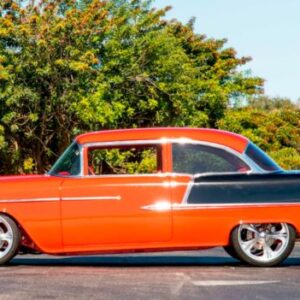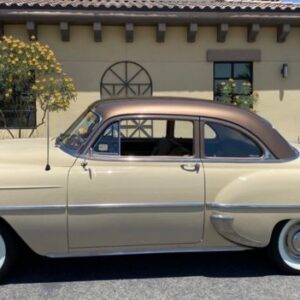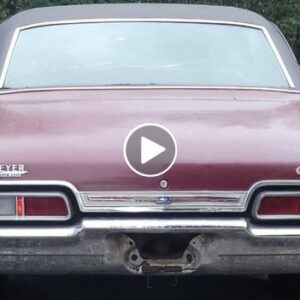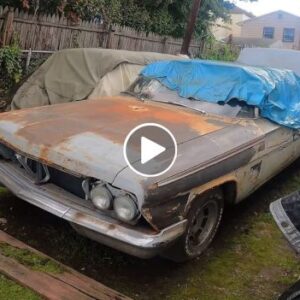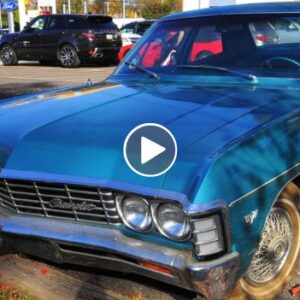The 1973 Dodge Dart is a classic American muscle car that has stood the test of time. Its unique combination of style, power, and performance has made it a favorite among car enthusiasts for decades. Whether you are a collector looking for a pristine example or a gearhead looking to restore a project car, the ’73 Dart is a fantastic choice.
-1686890826x1024.jpg)
In this article, we will dive into the history of the 1973 Dodge Dart, its specifications, and why it remains a popular choice for car enthusiasts today. Buckle up and let’s take a trip down memory lane with this classic muscle car.
1. A Brief History of the Dodge Dart
The Dodge Dart was first introduced in 1960 as a full-sized car. Over its 14-year production run, the Dart evolved through several different generations and body styles, eventually becoming a compact car. The 1973 model year marked the final iteration of the Dart, and it is this version that has become a sought-after classic.
-1686890856x1024.jpg)
The early 1970s were a period of change for the American automotive industry. The oil crisis and increasing government regulations resulted in a shift towards smaller, more fuel-efficient vehicles. Despite these challenges, the 1973 Dodge Dart managed to maintain its muscle car pedigree while adapting to the changing times.
2. Design
The 1973 Dodge Dart was a compact car produced by Chrysler under the Dodge brand. It was part of the fourth-generation Dart series, which was introduced in 1967 and remained in production until 1976. The design of the 1973 Dart had several distinctive features that were characteristic of its time.
Exterior
The Dart featured a boxy and angular design, which was common for cars of that era. It had a relatively long hood and a short deck, giving it a compact yet muscular appearance. The front end had a prominent grille with a center divider, flanked by quad headlights. The rear end had vertical taillights and a chrome bumper.
-1686890871.jpg)
Body Styles
The 1973 Dart was available in various body styles, including a two-door coupe, four-door sedan, and a four-door station wagon. Each body style had its own unique design elements, but they all shared the same overall aesthetic.
Size and Proportions
The Dart had a wheelbase of approximately 108 inches (274 cm) and an overall length of around 191 inches (485 cm). It was considered a compact car by the standards of that time.
-1686891272x1024.jpg)
Trim Levels
The 1973 Dart was offered in different trim levels, including the base Dart, Dart Custom, Dart Swinger, and Dart Sport. Each trim level had its own distinct features and styling cues.
Interior
The interior of the 1973 Dart featured a functional and straightforward design. It had bench seats with various upholstery options. The dashboard was simple and contained the essential gauges and controls. Higher trim levels offered more luxurious features and upgraded upholstery.
-1686890897x1024.jpg)
3.Engine and Performance
The performance of the 1973 Dodge Dart varied depending on the specific engine and trim level chosen. Here are some performance figures for the available engine options:
Base Slant-6 Engines
The base engine options for the 1973 Dart were the 198 cubic inch (3.2-liter) and 225 cubic inch (3.7-liter) inline-six engines. These engines provided decent fuel efficiency but were not known for their high performance. The horsepower output for these engines ranged from approximately 95 to 105 horsepower. Acceleration and top speed would be modest compared to the V8 options.
-1686890914x1024.jpg)
V8 Engines
The V8 engines offered more power and performance compared to the base Slant-6 engines. The 318 cubic inch (5.2-liter) V8 produced around 150-170 horsepower, depending on the configuration. The higher-performance options, such as the 340 cubic inch (5.6-liter) V8 and the 360 cubic inch (5.9-liter) V8, delivered greater horsepower, ranging from approximately 175 to 245 horsepower. These engines provided improved acceleration and higher top speeds compared to the Slant-6 engines.
Dart Sport Performance Model
The Dart Sport was the performance-oriented variant of the 1973 Dart. Equipped with the higher-output V8 engines, such as the 340 or 360 cubic inch V8, the Dart Sport offered enhanced performance capabilities. These models provided quicker acceleration, improved handling, and higher top speeds compared to the standard Dart models with the same engine options.
The performance figures mentioned above are approximate and can vary depending on factors such as specific engine tuning, optional equipment, and any modifications made over the years. Additionally, performance measurements from the 1970s may not align with modern standards, as emissions regulations and testing methods have evolved significantly since then.
4. Sales and Production
Here are the sales and production figures for the 1973 Dodge Dart:
Total production of 1973 Dodge Darts was 159,411 units. This was down over 50% from 1968 production of 316,704 Darts.
Of the 159,411 Darts produced, 142,295 were 4-door sedans, 14,528 were 2-door hardtop coupes, and 2,588 were station wagons. Dodge was phasing out the Dart wagon after 1973.
-1686890951.jpg)
Total U.S. sales of Darts in 1973 were 151,218 vehicles. Canadian sales added another 8,193 units. The best-selling Dart model was the 4-door sedan, with 134,684 units sold in the U.S. (89% of total Dart sales). Coupe models sold only 16,534 units.
5. Market Reception
The 1973 Dodge Dart received a lukewarm reception in the market. Some key points:
The oil crisis of 1973 and rising gas prices hurt demand for large cars like the Dart. Buyers shifted to more compact, fuel-efficient models. The Dart was based on an aging platform and had a dated design, at a time when competition from Japanese automakers was intensifying. The Dart looked dull and unappealing compared to competitors.
Reliability and quality issues plagued Chrysler and its Dodge brand in the early 1970s. This gave the Dart a poor reputation which further hampered sales. Sales of the Dart declined over 50% from 1968 to 1973. The Dart went from being Dodge’s best-selling model to struggling also-ran in the mid-size segment.
-1686890972.jpg)
Critics found the 1973 Dart to be poorly equipped, constructed and finished for the price. It was seen as inferior to competitors from Ford, GM, and Japan. Due to declining sales, 1973 was the last model year for the Dart nameplate in North America. Dodge discontinued the slow-selling car to focus on more competitive models.
So in summary, the market reception of the 1973 Dodge Dart was quite poor. It was a dated, unappealing car with quality issues, released at a time when buyer tastes and economic conditions had shifted strongly against Dodge’s offering. The Dart had rapidly gone from Dodge’s most important car to an albatross, leading to its cancellation after 1973.
6. End of Production
There are several reasons why Dodge discontinued the Dart after 1973:
Rapidly declining sales. Sales of the Dart plunged in 1973, down over 60% from 1972. The oil crisis crippled demand for mid-size cars like the Dart. Dodge could not justify continuing a model with such poor sales.
Competition from Japan. The 1973 Dart was no match for smaller, more efficient and reliable models from Toyota, Datsun and Mazda. Dodge was losing ground to Japanese automakers, and the Dart was emblematic of its competitive troubles.
-1686890990x1024.jpg)
New economy car focus. Dodge realized it needed competitive new designs to counter falling sales and Japanese competition. It shifted focus from the mid-size Dart to developing smaller, more fuel-efficient economy cars like the Aspen and Aries. The Dart was dropped in favor of these new models.
Brand repositioning. Chrysler was repositioning the Dodge brand towards smaller, more affordable models best suited to the times. The Dart was too large, inefficient and upscale for the new image and market niche Dodge aimed for. It no longer fit with the brand’s identity and direction.
7. Collectability
The collectability of a 1973 Dodge Dart can vary depending on several factors. Here are some key points to consider:
Condition
The condition of the vehicle plays a significant role in its collectability. A well-maintained, original, or fully restored 1973 Dodge Dart is generally more desirable and valuable to collectors. A car in excellent condition with minimal rust, a well-preserved interior, and a functional drivetrain would have higher appeal.
Rarity
The rarity of a particular model or variant can also impact collectability. Some 1973 Dodge Dart models, such as the high-performance Dart Sport 340 or the limited-edition Dart Swinger Special, may have higher demand due to their unique features or production numbers.
Historical Significance
The 1973 model year marked a significant change in the automotive industry due to the introduction of stricter emissions regulations. This could make the 1973 Dodge Dart an interesting collectible from a historical standpoint, representing a transition period in automotive manufacturing.
-1686891021x1024.jpg)
Popularity and Demand
The popularity of a specific make and model within the collector car community can influence its value. The 1973 Dodge Dart has a decent following among Mopar enthusiasts, but it may not have the same level of demand as some earlier or more iconic models from Dodge or other manufacturers.
Modifications
The extent to which the car has been modified from its original specifications can impact its collectability. Some collectors prefer vehicles that retain their original components and features, while others may appreciate tasteful modifications that enhance performance or aesthetics.
-1686891037x1024.jpg)
Documentation and Provenance
Having proper documentation, such as the original build sheet, owner’s manual, or maintenance records, can add value to a collectible car. Additionally, a vehicle with a well-documented history or provenance, such as limited ownership or an interesting story, may attract more attention from collectors.
8. Cultural Values
The cultural values associated with a 1973 Dodge Dart can vary depending on the perspective and context. Here are some aspects that may be associated with its cultural values:
Nostalgia
The 1973 Dodge Dart represents a specific era in automotive history, evoking feelings of nostalgia for those who experienced or appreciate the style, design, and overall aesthetic of that time period. It can be seen as a symbol of the 1970s and the automotive industry during that era.
-1686891053x1024.jpg)
American Muscle
While the 1973 Dart may not be classified as a traditional muscle car, it is part of the lineage of American muscle cars produced by Dodge. It carries the legacy of performance-oriented vehicles that were popular during the muscle car era. This can appeal to car enthusiasts who value the power, speed, and overall performance associated with muscle cars.
Reliability and Simplicity
The Dart was known for its durability and reliability, which were key values for many car buyers in the 1970s. It was considered a practical and affordable option for individuals and families looking for a reliable means of transportation. The Dart’s simplicity and straightforward design also resonated with buyers who preferred a no-frills approach to their vehicles.
-1686891098x1024.jpg)
Fuel Efficiency
The 1973 model year coincided with the oil crisis of the 1970s, which led to increased interest in fuel-efficient cars. The Dart, like many other vehicles of that time, had to adapt to stricter emissions regulations and fuel economy requirements. Its smaller size and engine options aimed at balancing performance and fuel efficiency can be seen as a cultural value tied to the energy crisis and environmental consciousness.
Individualism and Customization
The 1973 Dart provided a platform for personalization and customization. Many owners modified their Darts to reflect their unique style, whether through engine upgrades, exterior modifications, or interior enhancements. This aspect of personal expression and individualism is valued by car enthusiasts who appreciate the ability to make a vehicle their own.

